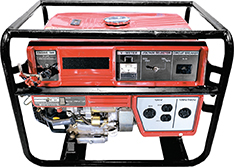You can buy a small AC generator to power electrical devices during a power outage or to use in areas not served by a power company. Figure 15 shows an AC generator that can produce 3300 watts of power. This is enough for a household or small business to use. Power plants use AC generators that are huge compared to the generator shown here.
Figure 15 Small generators provide power in areas that are not served by power companies. These generators may also be used to provide electrical energy during a power outage.

DC Generators
A DC generator produces a direct current. Its design is very much like the design of an AC generator except that a commutator replaces the slip rings. As the loop rotates, an alternating current is induced in the wire. First, one side of the commutator contacts a brush. When the loop rotates, current is induced in the other direction, but now the other side of the commutator contacts that brush. For this reason, the current that leaves the generator flows in only one direction.

What kind of current does a DC generator produce?
Transformers
The electrical energy produced by power plants is transmitted through power lines at very high voltages. These voltages are too high to be used safely in homes. The voltage must first be changed, or transformed. A transformer is a device that increases or decreases the voltage and current of two linked AC circuits. A series of transformers changes high-voltage current in power lines into 240-volt current that can be used safely in your home.
A transformer works only with alternating current because only alternating current induces a constantly changing magnetic field.  A transformer changes voltage and current by inducing a changing magnetic field in one coil. This changing field then induces an alternating current in a nearby coil with a different number of turns.
A transformer changes voltage and current by inducing a changing magnetic field in one coil. This changing field then induces an alternating current in a nearby coil with a different number of turns.
Why Transformers Are Needed
Early power plants used DC generators because the power plants were close to the customers. As the demand for electric power increased, power plants had to transmit power much farther. Remember that an electric charge moving through a wire heats the wire. Over long distances, the resistance of the wire causes large losses of power. Power losses can be reduced by using lower current transmitted at a higher voltage. However, voltage and current can be transformed only with alternating current.





